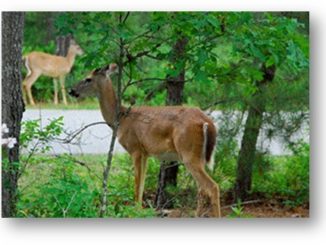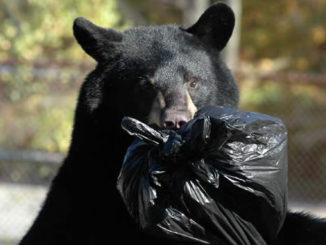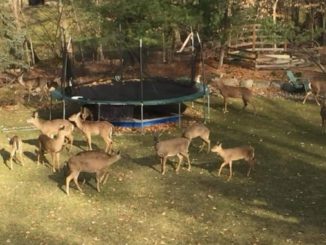
OLD TAPPAN, N.J.—While most Old Tappan council members admit deer are a nuisance, most had no new ideas Sept. 16 of how to better manage or reduce local deer numbers that one resident claimed are “a very real risk to causing [motor vehicle] accidents.”
A substantial increase in vehicle-deer “incidents” was one reason cited by neighboring River Vale council members before deciding to move forward with a possible deer bowhunt for 2020.
Old Tappan Mayor John Kramer, who said he attended at least four meetings on the rising deer population in the last two years, asked council members to provide input on a resident’s email stating he has suffered “hundreds of dollars” in landscape damage and that deer are all over yards.
Resident James West, Weidmann Court, said he “spotted several groups of deer” while driving home from Westwood.
The animals were “eating away at people’s landscaping [and] I have seen them on my front lawn eating our flowers,” he wrote.
West said the deer “have no fear of cars and are a very real risk to causing accidents. The damage to my property is in the hundreds of dollars and getting worse,” he wrote.
‘No reasonable answer’
“I really have seen no reasonable answer or no reasonable way” to manage deer, said Kramer.
He said Saddle River held a 2018 bowhunt to cull deer to reduce the population.
“I know of no other town in Bergen County that has a plan in action at this time,” he added, noting he was not sure about River Vale’s plans for a future hunt.
The hunt was postponed to at least 2020, reported Pascack Press Sept. 16, but no final decision has yet been made.
Due to a lack of information on potential safety concerns and other relevant data, River Vale Mayor Glen Jasionowki said recently that the hunt will not occur in 2019 and a decision for a 2020 hunt will likely occur in October.
For a hunt to occur in 2020, much preparation must occur, including passing ordinances, police coordination, and public safety measures in place, say River Vale officials.
“Please let us know what plans you and the [Old Tappan] council have regarding this,” wrote West, while asking the council to “mitigate the issues caused by deer damage to property.”
Although council members raised the idea of a deer survey, no action was taken.
In a drone survey earlier this year, River Vale found 96 deer per square mile town-wide, which far exceeded the area’s 10 deer per-square-mile biological carrying capacity, according to university wildlife experts.
Last year Saddle River killed 135 deer in its first bowhunt, which it coordinated with the state Department of Environmental Protection and United Bowhunters of New Jersey.
No ‘regional’ solution
Deer reduction efforts have been slow to start in Pascack Valley and Northern Valley towns. Efforts have been ongong to get “buy in” to a regional deer management approach, but an Englewood forum devoted to discussing regional efforts failed to generate a follow-up meeting among two dozen mayors and public officials present.
At the June Englewood forum on deer management strategies, a state wildlife division director, Carol Stanko, called on municipalities to undertake their own deer management strategies and not wait for a regional plan, which may never come, she said.
Besides two towns—Saddle River and River Vale—most towns have initiated no actions and have no plan to address an increasing deer population.
The topic rouses strong passions and incites animal-protection activists, making most local leaders hesitant to address such a politically sensitive matter.
At River Vale council meetings over summer and early September, children and teenagers have addressed council members to ask not to kill the deer and not use violence (i.e. hunting) to solve a problem. That town’s mayor, Jasionowski, said he was called a “serial killer” on social media by anonymous critics and recently said inaccurate information was regularly posted about the township’s possible deer hunt.
In Old Tappan, Councilman Jin Yhu, who attended the Englewood meeting, said he didn’t think Saddle River’s culling of 135 deer during a 2018 bowhunt “would make much of a dent” in regional deer numbers.
Councilman Ron Binaghi said he had heard about a surgical sterilization effort attempted in Central Jersey that did not work and which was very expensive.
The state Division of Fish and Wildlife does not currently approve of any non-lethal methods to reduce deer population, and disapproved of Saddle River’s initial proposal to use it, calling sterilization ineffective and experimental.
Binaghi said deer are not primary carriers of ticks that carry Lyme disease.
Also, he said, coyotes were here long before deer populations increased and the deer did not attract coyotes to the area, as some residents were posting on social media.
‘Getting rid of them’
“I’m not opposed to any suggestions that might include getting rid of them in some fashion,” Binaghi added. He said he “doesn’t want to get rid of them with car accidents” where a resident may be killed.
After hearing no deer solutions from the council, Kramer said he would provide an email response, noting “we have no plan of action at this time and we are monitoring what is going on throughout the county.”
“The governing body here will continue to participate in future related meetings and will monitor and consider reasonable control methods as they develop,” said Kramer in a Sept. 18 email reply to West’s concerns.
On a related topic, council members discussed a possible amendment to a fence ordinance to allow an increased height for “deer fencing.”
No draft amendment has yet been developed, said Anna Haverilla, borough administrator.
She said council members reviewed a recent Haworth ordinance that permitted increases up to nine feet for a deer fence. No action was taken.



